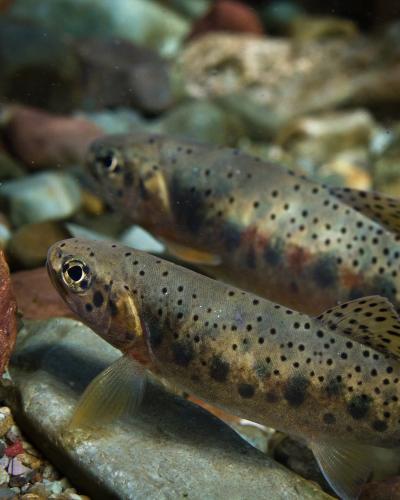A new paper in Nature Climate Change asserts that global warming is causing the hybridization of trout – interbreeding between native and non-native species – to increase in the interior western United States.
Specifically, they cite rapid increases in stream temperature and decreases in spring flow over the past several decades contributed to the spread of hybridization between native westslope cutthroat trout and the introduced rainbow trout – the world's most widely introduced invasive fish – across the Flathead River system in Montana and British Columbia, Canada. It's been hypothesized that climate change could decrease worldwide biodiversity through cross-breeding between invasive and native species, but this paper is the first to directly support this prediction.
Hybridization has contributed to the decline and extinction of many native fishes worldwide, including all subspecies of cutthroat trout in western North America, which have enormous ecological and socioeconomic value. The researchers used long-term genetic monitoring data coupled with high-resolution climate and stream temperature predictions to measure whether climate warming enhances interactions between native and non-native species through hybridization.

Native westslope cutthroat trout are shown in the North Fork Flathead River, the study area for the published article. Photo courtesy of Clint Muhlfeld
"Climatic changes are threatening highly prized native trout as introduced rainbow trout continue to expand their range and hybridize with native populations through climate-induced 'windows of opportunity,' putting many populations and species at greater risk than previously thought," said lead author Clint Muhlfeld, a research assistant professor in the University of Montana Division of Biological Sciences' Flathead Lake Biological Station and research ecologist with the USGS Northern Rocky Mountain Science Center in Glacier National Park.
"The study illustrates that protecting genetic integrity and diversity of native species will be incredibly challenging when species are threatened with climate-induced invasive hybridization."
Westslope cutthroat trout and rainbow trout both spawn in the spring and can produce fertile offspring when they interbreed. Over time, a mating population of native and non-native fish will result in only hybrid individuals with substantially reduced fitness because their genomes have been altered by non-native genes that are maladapted to the local environment. Protecting and maintaining the genetic integrity of native species is important for a species' ability to be resilient and better adapt to a rapidly changing climate.
Historical genetic samples revealed that hybridization between the two species was largely confined to one downstream Flathead River population. However, the study noted, during the past 30 years, hybridization rapidly spread upstream, irreversibly reducing the genetic integrity of native westslope cutthroat trout populations. Genetically pure populations of westslope cutthroat trout are known to occupy less than 10 percent of their historical range.
The rapid increase in hybridization was associated with climatic changes in the region. From 1978 to 2008, the rate of warming nearly tripled in the Flathead basin, resulting in earlier spring runoff, lower spring flooding and flows, and warming summer stream temperatures. Those locations with the greatest changes in stream flow and temperature experienced the greatest increases in hybridization.
Relative to cutthroat trout, rainbow trout prefer these climate-induced changes and tolerate greater environmental disturbance. These conditions likely have enhanced rainbow trout spawning and population numbers, leading to massive expansion of hybridization with westslope cutthroat trout.
"The evolutionary consequences of climate change are one of our greatest areas of uncertainty because empirical data addressing this issue are extraordinarily rare," Kovach said. "This study is a tremendous step forward in our understanding of how climate change can influence evolutionary process and ultimately species biodiversity."
Overall, aquatic ecosystems in western North America are predicted to experience earlier snowmelt in the spring, reduced late spring and summer flows, warmer and drier summers, and increased water temperatures – all of which indicate increased hybridization between these species.





Comments